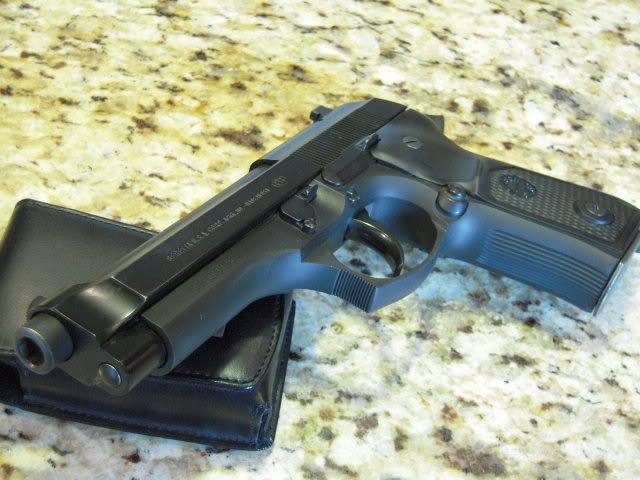So does the 10k general rule apply to straight and slanted dust cover guns, or only to straight? Was there any improvement made with the change in frame design?
So does the 10k general rule apply to straight and slanted dust cover guns, or only to straight? Was there any improvement made with the change in frame design?
When I give private lessons, if I need to demo, I use the student's gun. That way they don't think I'm using a tricked out SCCY to be able to shoot well.
In fairness to Beretta, some 8 or 9 years ago they did significantly strengthen the OEM trigger return spring, but the recommended replacement interval is still every 5K manipulations; I believe that the strengthened spring simply provides a needed level of assurance that it's capable of reaching the 5K point. While 5K iterations may seem like a lot to many shooters, if you factor in any sort of a dryfire program, that point is reached pretty quickly.
In comparison, Wolff attests that their Trigger Conversion Unit has literally undergone tens of thousands of rounds in testing without failure. One caveat to it is that the Wolff TCU will not work with the newer polymer triggers on current production Beretta 92 guns; they require the older steel-and-Bruniton-coated trigger (which my understanding is can be drop-in retrofitted to the newer guns if desired, which would then facilitate use of the Wolff TCU).
In my personal experience (with a sample size of 2 92Ds; a 92D Centurion I had years ago, and my current 1996-vintage 92D, which I obtained brand-new-in-box in 2006) the triggerpull of a 92D is much like a well-tuned Smith & Wesson revolver; which trigger return spring used is irrelevant, as the triggerpull itself is controlled by the triggerbar spring (but I've also replaced my OEM triggerbar and slide release springs with Wolff replacements). In my opinion, a 92D in decent shape is well worth the price of admission (which is likely to be conveniently discounted, as DAO automatics are not held in high esteem by many, as they're often considered to be more difficult to use/master than their DA/SA compatriots-neither of which I consider to be valid with proper familiarization, experience, and training). As Tamara did, mine is used as a nightstand gun, due to the combination of its trigger/action, Trijicon nightsights, and simplicity of operation-nice if I have to pass it to my wife to use. I also installed a set of Trausch TJ 92 ultrathin polymer/fiberglass grips, which I find very favorably increase the handling characteristics of the 92.
Best, Jon

Last edited by JonInWA; 11-11-2011 at 03:24 PM.
Would using a heavier recoil spring in the 96 series Beretta's help extend the life? I don't understand why Beretta uses the same strength spring for both the 9mm and .40 cal rounds. Wolff offers recoil springs which are a few pounds heavier than stock. Would they be advisable for a 96?
Elimination of the manual safety/decocker lever also eliminated an area susceptible to dust/dirt infiltration (which could operationally hinder the gun if the the safety's movement was sufficiently inhibited), and also made the slide slightly stronger, as elimination of the levers also eliminated the need for a stress-reduction cut. Beretta actually semi-officially termed the D guns "slickslides," calling them out as such in their catalogs and promotional information back in the day. Shortly after D model production commenced (back around 1992, if my memory serves me correctly) Beretta also extended the number and coverage area of the slide grasping grooves (mine pictured above is a 1996-vintage gun with the increased grooving).
Best, Jon
I am not a physicist, nor an engineer, but that just doesn't seem to track. I would imagine the recoil forces are far in excess of the forces that would be imparted by a 5-8lb increase in spring weight.
I guess we will find out, I just started running a 20lb recoil spring in my 96D.

Yes, but the gun is designed to absorb large amounts of recoil force in one direction and not designed to absorb forces in the other direction. Looking at my pistol, the slide will reach its rearward limit of travel when the recoil spring is fully compressed and the slide contacts the frame with the frame absorbing any remaining force. When the pistol goes into battery, the recoil spring drives the slide forward with the slide stopping once the locking lugs are seated and the bottom of the locking block is resting against the takedown lever. The area on the frame where the slide contacts is designed to absorb far more force than the takedown lever and locking blocks are. I'm not offering cannon here, maybe Todd can give Beretta's real rational here, just offering a possible explanation.
Please keep me informed on how it works for you.
Sent an e-mail off to Beretta USA concerning this issue.
Their answer.Are there any issues associated with running a 20lb recoil spring in an older (1997 production) Beretta 96D? Knowing that there are frame durability issues with this particular model I felt it a prudent step to use a heavier recoil spring, however the heavier spring also imparts greater "abormal" forces on the frame than a stock spring would. Are there any known issues to be present with using a heaver spring?
Unless I hear something relatively definitive and the gun remains functional I plan to stay with the 20lb recoil spring. I figure if nothing else it can serve as a test bed for anyone who might be thinking about running a heavier spring.BerettaUSA does not suggest the use of non-factory approved parts in our firearms. While this spring may work with your firearm, it will most definitely cause cycling issues with lighter loaded .40S&W.